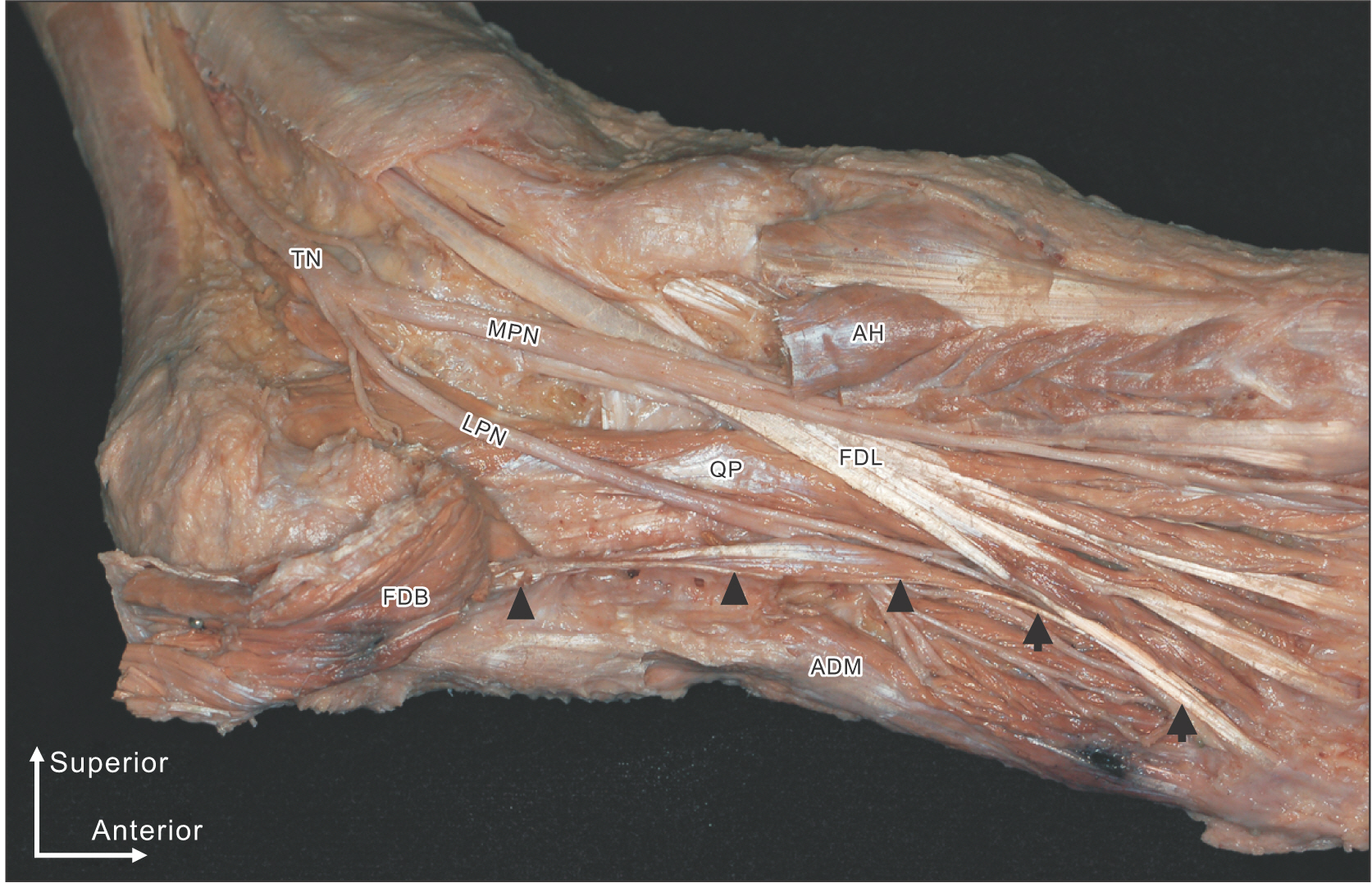Anat Cell Biol.
2023 Sep;56(3):401-403. 10.5115/acb.23.092.
Separated muscle belly of the flexor digitorum brevis for the fifth toe: a case report
- Affiliations
-
- 1Department of Anatomy, Daegu Catholic University School of Medicine, Daegu, Korea
- 2Department of Anesthesia and Pain Medicine, Kyungpook National University Hospital, Daegu, Korea
- KMID: 2546470
- DOI: http://doi.org/10.5115/acb.23.092
Abstract
- This case report describes a variation of the flexor digitorum brevis (FDB) with a separated muscle belly and tendon at the fifth toe. The narrow tendon and muscle belly for the fifth toe arose from the intermuscular septum between the FDB and abductor digiti minimi adjacent to the arising fibers of the FDB, separating from its other fibers. The tendon and muscle belly for the fifth toe became wider at the base of the metatarsal bones and narrower as it coursed toward the toes in a fusiform shape. The tendon and muscle belly for the fifth toe became thin at the midfoot and coursed just beneath the flexor digitorum longus tendon and entered the digital tendinous sheath. FDB variations including that described herein should be considered when performing various surgical procedures and evaluating the biomechanics of the foot.
Keyword
Figure
Reference
-
References
1. Farris DJ, Kelly LA, Cresswell AG, Lichtwark GA. 2019; The functional importance of human foot muscles for bipedal locomotion. Proc Natl Acad Sci U S A. 116:1645–50. DOI: 10.1073/pnas.1812820116. PMID: 30655349. PMCID: PMC6358692.
Article2. Lobo SW, Menezes RG, Mamata S, Baral P, Hunnargi SA, Kanchan T, Bodhe AV, Bhat NB. 2008; Phylogenetic variation in flexor digitorum brevis: a Nepalese cadaveric study. Nepal Med Coll J. 10:230–2. PMID: 19558059.3. Yammine K. 2015; The fourth slip of the flexor digitorum brevis muscle of the human foot. A systematic review and meta-analysis. Ital J Anat Embryol. 120:59–70. DOI: 10.53347/rid-44457.4. Standring S. 2020. Gray's anatomy: the anatomical basis of clinical practice. 42nd ed. Elsevier;DOI: 10.5860/choice.43-1300.5. Tubbs RS, Shoja MM, Loukas M. 2016. Bergman's comprehensive encyclopedia of human anatomic variation. Wiley-Blackwell;DOI: 10.1002/9781118430309.6. Rosse C, Gaddum-Rosse P. 1997. Hollinshead's textbook of anatomy. 5th ed. Lippincott-Raven.7. Grogono BJ, Jowsey J. 1965; Flexor accessoreus longus: an unusual muscle anomaly. J Bone Joint Surg Br. 47:118–9. DOI: 10.1302/0301-620X.47B1.118. PMID: 14296234.8. Kelly LA, Cresswell AG, Racinais S, Whiteley R, Lichtwark G. 2014; Intrinsic foot muscles have the capacity to control deformation of the longitudinal arch. J R Soc Interface. 11:20131188. DOI: 10.1098/rsif.2013.1188. PMID: 24478287. PMCID: PMC3928948.
Article9. Smith RE, Lichtwark GA, Kelly LA. 2022; Flexor digitorum brevis utilizes elastic strain energy to contribute to both work generation and energy absorption at the foot. J Exp Biol. 225:jeb243792. DOI: 10.1242/jeb.243792. PMID: 35344050. PMCID: PMC9124483.
Article10. Ikuta Y, Murakami T, Yoshioka K, Tsuge K. 1984; Reconstruction of the heel pad by flexor digitorum brevis musculocutaneous flap transfer. Plast Reconstr Surg. 74:86–96. DOI: 10.1097/00006534-198407000-00013. PMID: 6739603.
Article11. Yalçin B, Ozan H. 2005; Some variations of the musculus flexor digitorum brevis. Anat Sci Int. 80:189–92. DOI: 10.1111/j.1447-073X.2005.00112.x. PMID: 16333914.
Article12. Bernhard A, Miller J, Keeler J, Siesel K, Bridges E. 2013; Absence of the fourth tendon of the flexor digitorum brevis muscle: a cadaveric study. Foot Ankle Spec. 6:286–9. DOI: 10.1177/1938640013489342. PMID: 23687345.13. Quiñones-Rodriguez JI, Mantilla-Rosa C, Rodríguez F, Villamil CI, Fernández J, González-Solá M, Torres-Toro C, Rosario MG. 2022; A missing flexor digitorum brevis tendon and its relationship to sex and ancestry: evaluation in Hispanic population. Anatomia. 1:210–6. DOI: 10.3390/anatomia1020021.
Article14. Ilayperuma I. 2012; On the variations of the muscle flexor digitorum brevis: anatomical insight. Int J Morphol. 30:337–40. DOI: 10.4067/S0717-95022012000100059.
Article15. Stimec BV, Dash J, Assal M, Stern R, Fasel JHD. 2018; Additional muscular slip of the flexor digitorum longus muscle to the fifth toe. Surg Radiol Anat. 40:533–5. DOI: 10.1007/s00276-018-1991-7. PMID: 29473094.
Article
- Full Text Links
- Actions
-
Cited
- CITED
-
- Close
- Share
- Similar articles
-
- Muscular Variations of Extensor Digitorum Brevis Muscle Related with Anterior Tarsal Tunnel Syndrome
- Anatomical variation of quadratus plantae in relation with flexor digitorum brevis
- Carpal Tunnel Syndrome Caused by Anatomic Variation of Flexor Digitorum Superficialis of Little Finger
- Extensor Digitorum Brevis Innervated by the Tibial Nerve (All Tibial Foot): A case report
- The Tendinous Slip of the Flexor Digitorum Longus for the Great Toe: An Anatomic Variation


